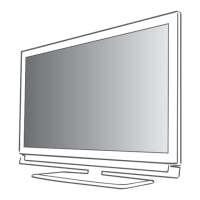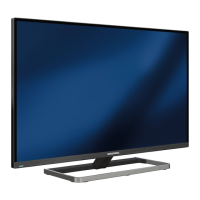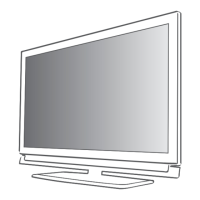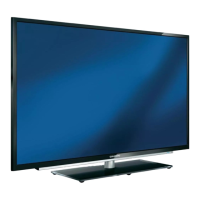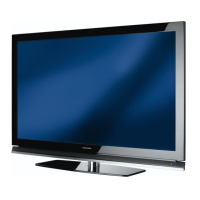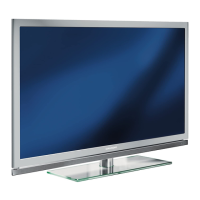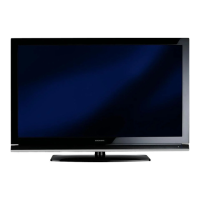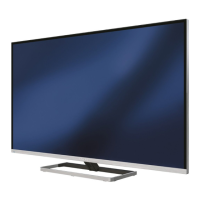Do you have a question about the Grundig 42 VLE 922 BL and is the answer not in the manual?
An overview of the television's key features and capabilities.
Instructions on how to receive digital TV channels via satellite, terrestrial, and cable.
Explanation of the Grundig SCR system for satellite reception.
Important guidelines for environmental protection and energy saving.
Steps for connecting the antenna and power cord to the TV.
Instructions on how to insert batteries into the remote control.
Diagram and description of all available connection ports on the television.
Explanation of the buttons and controls located on the television set itself.
Details on the primary functions of the television's remote control.
Information about the alternative voice-controlled remote.
Guide for the initial setup and tuning of television channels.
How to select language, country, and operating mode during setup.
Step-by-step guide for tuning satellite TV channels.
Instructions for tuning terrestrial digital TV channels.
Guide for tuning digital TV channels from a cable provider.
How to change the order, delete, or lock digital channels.
Steps to remove unwanted channels from the program table.
How to mark channels to be skipped during channel selection.
Guide to saving and organizing favorite channels into lists.
Adjustments for brightness, contrast, color, sharpness, and picture modes.
Options for adjusting volume, balance, sound modes, and night mode.
Feature to maintain consistent volume across channels.
How to select audio channels or switch to mono.
Instructions for turning the television on and off or putting it into standby.
Methods for selecting channels directly, via list, or step-by-step.
How to increase or decrease the TV's volume.
How to view information about the current program.
How to pause the current video frame.
Options for adjusting audio presets, language, and subtitles.
How to enlarge the picture for a closer view.
How to activate Eco mode to reduce power consumption.
Setting a timer for the TV to automatically switch off.
Remembers channels for quick switching between watched channels.
Overview of upcoming TV programs for digital channels.
Adjusting the aspect ratio of the displayed picture.
Essential safety and usage information for 3D viewing.
Steps and requirements to get ready for 3D viewing.
Guidelines and notes for viewing 3D content.
Configuration options for 3D display effects and perspective.
Customizing 3D effects when converting 2D content.
Correcting 3D perception issues due to synchronization shifts.
How to connect the TV to a network using a wired Ethernet cable.
Options for automatic or manual wired network configuration.
Steps for manual IP address configuration for static networks.
How to connect the TV to a wireless network using a WiFi dongle.
Steps for manual configuration of wireless network settings.
Information about available internet applications and the GRUNDIG Application store.
How to navigate menus and input text using the virtual keyboard.
Steps to register and create a user account for the GRUNDIG App store.
Process for logging into the GRUNDIG Application store with existing credentials.
How to browse and select applications from the GRUNDIG store.
Steps to download and install applications from the online store.
How to remove installed applications from the TV.
How to change the order of installed applications.
How to rate applications installed on the TV.
Options for how applications are displayed while using them.
Overview of the main menu structure for applications.
Information about using Skype for audio and video calls via the TV.
Instructions for connecting and setting up a compatible camera for Skype.
Step-by-step guide to creating a new Skype account on the TV.
How to add new contacts to your Skype list.
Methods for making audio and video calls using Skype.
How to make calls to phone numbers using Skype Credit.
How to accept incoming Skype calls while watching TV.
How to set your online presence status in Skype.
Accessing call history and changing user profile settings.
Information on how Skype application updates are handled.
Information on using the BABYWATCH application for child monitoring.
How to access and play media files from a home network using DLNA.
Steps to discover and select a DMS device on the network.
How to start playing selected media files.
Controls for pausing, resuming, stopping, and navigating media playback.
Lists of supported video, audio, and image file formats for USB playback.
Instructions for safely connecting USB storage devices.
Procedure for safely disconnecting USB storage devices.
Navigating and viewing files stored on USB media.
How to access and navigate the USB setup menu.
Enabling a preview of selected files in the file browser.
Choosing how files are displayed in the USB browser.
Information on playing DivX Video-On-Demand content.
Controls for playing video, audio, and image files from USB.
Advanced playback controls for DivX files and selected titles.
Navigating through chapters of DivX video files.
How to play only the marked tracks or files.
Stepping through tracks or pictures using skip functions.
Adjusting playback speed for fast forward and backward.
Options for repeating current or all tracks during playback.
Using advanced teletext modes with color buttons.
Switching to TV program while teletext page is loading.
Increasing the text size for better readability.
Stopping automatic scrolling of teletext sub-pages.
Directly accessing specific sub-pages within teletext.
Displaying hidden answers or information on teletext pages.
Viewing TV channel and teletext side-by-side.
Explanation of HbbTV as next-generation interactive teletext.
Controls for playing video sequences within HbbTV services.
How to access the main settings menu.
Selecting the preferred language for the TV's menu interface.
Setting primary and secondary audio languages for digital channels.
Managing subtitle display options for digital channels.
How to automatically or manually set the TV's date and time.
Setting timers for the TV to switch on or off automatically.
Scheduling the TV to turn on at a specific time.
Setting access levels and PIN codes to restrict content.
Preventing unauthorized access to certain menu options via PIN.
Automatic standby mode activation after a period of inactivity.
Disabling the physical buttons on the TV set.
How to change the default or current PIN code.
Restricting access to specific TV channels using a PIN.
Procedure to access a channel that has been locked.
Adjusting the brightness of the standby LED.
Updating TV software via satellite broadcast.
Updating TV software via an internet connection.
Resetting the TV to factory default settings, erasing all custom configurations.
Explanation of the DIGI LINK (CEC) feature for controlling connected devices.
How to find and connect external devices via DIGI LINK.
Controlling external devices using the TV's remote control.
Automatically switching connected devices to standby mode.
Information about connecting sources for HD content viewing.
Overview of available sockets and connection types for external devices.
How to connect devices using HDMI and SCART cables.
Steps for connecting devices using Component (YPbPr) cables.
Guide for connecting devices using SCART for CVBS/RGB signals.
Instructions for connecting devices using S-Video and audio cables.
Connecting devices using AV2 for analogue TV signals.
Operating external playback devices and selecting input sources.
How to connect headphones and adjust their volume.
Connecting digital multi-channel amplifiers or AV receivers via HDMI ARC or Optical Out.
Enabling and configuring the HDMI ARC feature for audio output.
Routing TV audio signals to a Hi-Fi system or AV receiver.
Steps to connect a PC to the TV for use as a monitor via VGA and audio cables.
Choosing predefined settings for PC display.
Adjusting PC display settings like auto-adjust, position, size, and phase.
Explanation of the Common Interface for DVB receivers and encrypted channels.
Managing access to pay-TV channels via CI module and smart card.
Performing an automatic search for new satellite channels.
Manually tuning satellite channels using specific parameters.
Configuring LNB power, type, and selection for satellite reception.
Adjusting satellite antenna alignment using DiSEqC 1.2 protocol.
Performing an automatic scan for channels from a cable provider.
Manually tuning channels from a cable provider using frequency.
Performing an automatic scan for digital terrestrial TV channels.
Automatically updating network operator information.
Manually tuning digital terrestrial TV channels by channel number.
Setting up analogue channels when digital reception is not available.
Manually tuning channels by entering their specific numbers.
Removing stored channels from the program table.
Assigning custom names to channels.
Marking channels to be skipped during channel selection.
Saving and organizing favorite channels into up to four lists.
Checking signal strength, quality, and other reception parameters.
Switching the HbbTV feature on or off.
Enabling or disabling digital teletext for normal teletext viewing.
Technical specifications and energy efficiency class of the TV.
Technical details for satellite, cable, and terrestrial reception.
Details on audio output, LNB supply, DiSEqC, and dimensions.
Information for service personnel regarding product compliance and directives.
Information on product recycling and responsible disposal.
A table listing common problems, their causes, and remedies.
